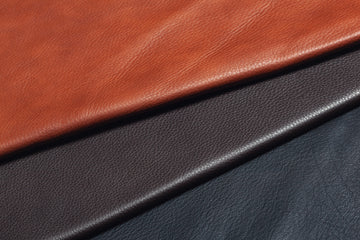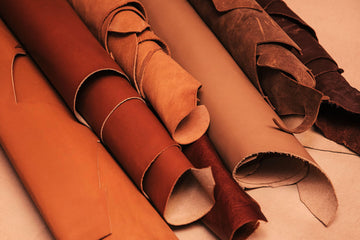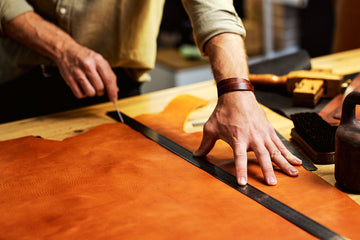Types of Leather Hides – A Comprehensive Guide to Buying Leather
Do you ever ponder which leather type would work or what type of leather is the best for your project, though? When creating unique and durable leather pieces, there's a vast range of possibilities – various types, finishes, and thicknesses. This guide provides an overview of the available options so that informed choices can be made when selecting what type of leather is the best for your project to craft one-of-a-kind items.
Key Takeaways
When selecting leather for a project, consider the type of project, desired durability and visual appeal.
Understand the differences between full grain leather, top grain leather, bonded leather and genuine leather to make an informed decision.
Repurposing leather scraps is also an option when crafting accessories or embellishments. Choose suitable scraps considering factors such as type of project and aesthetics.
Determining the Ideal Leather for Your Project
The proper selection of leather is necessary to attain the desired outcome for your project. Factors such as type, rigidity and aesthetics must be considered when deciding which hide is best suited for a specific task, whether creating an attractive wallet or making a long-lasting belt.
When it comes to crafting bags and wallets, bovine hides, cowhide, or sheepskin are ideal materials to use. For producing high-quality belts, double butts made of vegetable-tanned leather or chrome-tanned calfskin with thicknesses ranging between 8 - 13 oz (3mm - 5 mm) provide superior durability. It's essential to consider the hardness and endurance of chrome-tanned versus vegetable-tanned leather when choosing the correct tanning method that aligns with the goals you have set out.
Project Type and Purpose
When selecting the correct type of leather used for clothing and garments, some essential factors are durability, resistance, aesthetics, finishing type/grain/weight of the material, and its hand. Nubuck leather is an ideal choice here. It's made from sheep or goat skins, which render a soft yet light product in terms of thickness (1 - 3 oz.).
For projects like bags and wallets with more strength required but still maintaining flexibility, cowhide medium thick leather would be preferred. Vegetable vegetable-tanned leather, on the other hand, has that firmer feel necessary when creating items such as belts or knife sheaths so it would make a good option for these types of projects, too.
Durability and Resistance
Leather is ideal for long-term use due to its robustness and durability. The lasting power of a leather material can be assessed by several factors, such as the type of leather, thickness, and tanning process used on it.
Tanning significantly improves the resistance against damage from bacteria, mould or insects while enhancing tensile strength. Vegetable tanned leather presents more stiffness, whereas chrome tanned leather provides suppleness with greater flexibility. Thicker cuts are sturdier than thinner ones, which may provide malleability when crafting them into desired shapes or accessories but reduce longevity accordingly.
Aesthetics and Finishing
When selecting leather, the finishing process is essential in determining its look and feel. Aniline, semi-aniline, pigmented, or pull-up can all influence how leather appears once finished, while black and brown are especially desirable for wallets or purses.
When considering aesthetics, there is a significant distinction between the two chrome tanned leather or oil tanned leather and vegetable types of tanned leather. Vegetable tanning produces a beautiful patina, whereas chrome tanned offers more uniformity and durability over time.
So be sure to consider the type of finish you're looking for and colour options before making your purchase decision if perfection matters to details!
Understanding Different Leather Types
When it comes to selecting the best leather for a project, understanding the various types of available options is vital. There are four significant categories of leather – full grain, top grain, bonded and genuine, each with unique characteristics that make them more suitable or unsuitable for specific tasks.
In this article, we will discuss in greater detail these main leather type categories: full-grain, top-grain, bonded leather, split leather, and genuine. We'll look at their features so you can be better informed when choosing which type of synthetic leather works best for your needs.
There are different types of leather available in the market. Full-grain leather is made without sanding or buffering during production and contains only natural substances. Top-grain leather, on the other hand, has modified surface elements to create an artificial texture. Bonded split leather is made by glueing together scraps of regular hides and is composed of only natural substances. Genuine leather is primarily made from animal hide blended with synthetic materials like vinyl resin.
Each type of leather has its advantages and disadvantages. Knowing which option suits you best can ensure the selection process is executed effectively. This results in satisfactory outcomes due to carefully choosing appropriate quality-based material to deliver the end product.
Full Grain Leather
Leather made from full grain is held in the highest regard due to its unmatched strength and durability, derived directly from natural substances and cowhide's top layer. Its natural grain structure and irregularities also provide a unique aesthetic quality. Over time, this leather type will develop an attractive patina, making it even more eye-catching.
On the other hand, corrected grain leather offers a less expensive alternative, chrome vegetable-tanned leather. Still, it retains many desirable traits, such as remarkable resilience since it comes straight out of top layers of cowskin hide yet lacks some distinguishing features found on full grains vegetable tanned leather, like their undisturbed texture or charming aging process.
Top Grain Leather
Grain leather, especially top grain leather, is a step below full grain regarding quality. By removing the outermost layer of leather hide containing any irregularities and then sanding down the surface for a smooth look, this material gains its signature strength and stiffness compared to other types.
Although more natural and resilient than full-grain varieties. Thanks partly to its cost efficiency, it's an acceptable choice for projects under budget constraints.
Bonded, Split, and Genuine Leather
Genuine bonded or split leather and faux leather are lower-quality materials, making them less suitable for many applications. Bonded or split leather is constructed from genuine leather scraps mixed with adhesives, which get pressed onto a cloth backing. Only having 10-20% of real hide content makes it untrue skin.
On the other hand, full-grain and top-corrected grain leather items have higher strength, lastingness and durability compared to these two types of low-grade alternatives.
Leather Tanning Methods: Veg Tanned vs. Chrome Tanned
When deciding on the best type of leather for a given project, it is essential to understand how different tanning methods can affect its characteristics. Chrome and vegetable tanning are two primary ways of treating hides that differ significantly in durability, appearance, and overall suitability.
Below, we will take an in-depth look into these processes so you can make an educated decision when selecting the right leather for your purposes.
Vegetable Tanning Process
Vegetable tanning is one of the oldest methods to create leather, which can be dated back to prehistory. This process involves using natural tree components, including tannins and bark pieces, that produce a firmer finished product consistency. It is also known by its alternate name, veg-tanned leather or veg-tanned leather with veg tan used only.
As it does not come with much decoration or colour already added, this type of vegetable-tanned leather has been embraced for many projects involving items such as knife sheaths, belts or saddles due to its high customisation capabilities like engraving etching and dyeing.
Chrome Tanning Process
The chrome tanning process uses certain chemicals to speed up the procedure and make it more affordable than vegetable-tanned leather. Chrome alum and chromium sulfate are combined with strengthening collagen fibres, making the chrome tanned leather material softer with greater flexibility. There is an environmental issue and a need for more craftsmanship when buying vegetable-tanned leather made with traditional vegetal techniques.
Deciding which type (vegetable or chrome) suits your desired result best should depend on personal preference and other considerations such as cost-effectiveness and desired quality results. Both varieties have pros and cons, but ultimately, it is down to what you require from them to determine which would be better suited for use.
Choosing the Perfect Leather Thickness
One factor to consider when picking the best leather for your project is its thickness. The amount of ounces will measure how thick or thin a material is. An ounce amounts to 1/64th inch or 0.4mm in US measurements.
Below are descriptions of three different types of leather– thin, medium and thick– along with instructions as to which type of leather should be used depending on what you plan to use it for:
Thin Leather
Leather, particularly thin leather made of sheep or goat skins, is prized for its suppleness and flexibility. It can create items such as clothing, accessories, pockets, and bags small enough for cutouts on thicker skin types buying leather. To wooden knife sheaths covered in leather finishing, with the material's soft temper refined texture, all boasting an elegant appearance that makes them very popular crafting choices.
Taking care when working with thin leather will ensure it does not snag or become damaged while providing creative results featuring intricate designs.
Medium Leather
Medium leather is a versatile material commonly used for creating bags, wallets, and other crafts due to its adaptability. This type of leather hide has a thickness range from 1.0 mm to 2.0 mm, making it suitable for various uses, such as upholstery projects and crafting leather goods like armour pieces. It offers the perfect combination of durability and workability, making it an ideal choice for crafting and DIY projects.
Cowhide, one popular choice among medium leathers, ensures this kind of strength with more ease in manipulation when dealing with upholstery projects unrelated to any of the mentioned fields above!
Thick Leather
Heavy-duty items like belts, saddles and knife sheaths require a strong material to endure over time - this is why thick cowhide leather has become the go-to choice for such projects. It typically comes split into two parts since it measures in ounces because of its thickness.
Because of its substantial strength and stretch resistance, upholstery or saddle makers appreciate this type of leather due to how well it maintains shape even with regular use. This quality allows their upholstery leather or products to have an improved level of endurance than thinner materials can provide, making selecting thick leather an attractive option when durability matters most!
Sourcing Quality Leather Hides
Leather crafting requires sourcing durable leather hides with high-quality characteristics. One must consider the various leather thicknesses, water resistance, and supple texture to ensure this. Along with marks such as scars or natural variations. This section offers advice on finding a reliable supplier for quality leathers that are both long-lasting and aesthetically pleasing.
To begin your search, you should be well versed in understanding types of leather, including tanning methods and their associated thicknesses, which can assist in narrowing down options to select from upon encountering potential suppliers in your quest. Utilising these criteria makes it easier to make an informed decision towards choosing superior quality material for projects requiring dependable materials produced through knowledge regarding all aspects of genuine hide textiles available within the industry world's best leather used today.
This process is invaluable not only because you have ensured yourself peace of mind but also so that any product made using said materials has been crafted responsibly by taking into consideration ethical practices such as creating environmentally sustainable outcomes during production, thus ensuring longevity against environmental factors over time making sure each item invested money within holds its value going forward.
Identifying Quality Leather
Factors such as grade, hide, and tanning must be considered when assessing leather quality. To recognise good leather, one should check its scent (it should have no unnatural or plastic smell) and touch it to see if it is soft yet has a consistent grain pattern.
Genuine animal material labels will help identify high-quality products. As for purchasing scraps of this product, research the mentioned characteristics before investing. These considerations could decide whether your project is successful or not.
Repurposing Leather Scraps for Creative Projects
Regarding recycling leather scraps—a common by-product of the world's world's leather, goods and processing industries—a little creative thinking can yield exciting results. Discerning which pieces offer the right size and texture for your chosen project is critical in repurposing these materials into unique handmade items you can feel good about using or giving as gifts.
We will now explore ways to identify suitable pieces of leather scrap. We'll examine projects from creating accessories patchwork designs to embellishment details – all possible with just several small bits of ''up-cycled'' leather!
Project Ideas for Leather Scraps
Leather scraps can easily be employed in many projects, such as small accessories, patchwork and ornamental touches. Ideas for imaginative ways to use these leather leftovers are numerous: making keychains, wallets, tassel-decorated key holders, bag/pillow straps, and baby footwear ornaments like earrings and jewellery pieces, all from the same material!
Summary
With the help of this comprehensive guide, you can make informed decisions when selecting the right leather part for your project. By knowing what factors to consider, like types and tanning methods, and where to find quality materials from reliable suppliers, you are equipped with all the knowledge necessary to craft beautiful, durable leather goods. So go forth confidently on your journey, creating one-of-a-kind pieces that will stand the test of time.
Explore our wide selection of leather hides available in various colours and styles. Whether starting a craft project or needing large amounts of whole hides, we've got you covered. You can easily buy our premium quality leathers and hides online and get them delivered to your doorstep anywhere in the world without delay.
If you have any questions regarding the various types and grades of leather used for your leather projects, please do not hesitate to contact us. We aim to provide you with a clear understanding of each leather type and assist you in selecting the most suitable one for your bag to enhance its aesthetics and ensure its durability.






